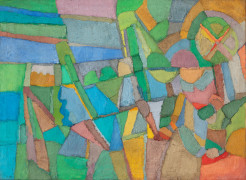Additional info:
Amine El Bacha emerged as one of the most distinctive figures of Lebanese modernism, cultivating a visual language that fused intellectual inquiry with sensory perception. Trained at the Lebanese Academy of Fine Arts in Beirut under César Gemayel, Jean-Paul Khoury, and Fernando Manetti, he later pursued advanced studies in Paris with Maurice Brianchon and Henri Goetz at the École Nationale Supérieure des Beaux-Arts and the Académie de la Grande Chaumière. His early formation reflected an enduring preoccupation with colour as an autonomous expressive medium, while his Parisian years transformed this pursuit into a semiotic system rooted in tone, rhythm, and compositional balance. El Bacha’s practice wove together painting, music, and memory, articulating an aesthetic that privileged intuition over imitation. His chromatic sensibility—shaped by the Mediterranean light of Beirut and the rural atmospheres of Mount Lebanon—expanded through the experimental climate of post-Cubist modernism. Across his career, he sought to reconstruct perception through abstraction, allowing colour to act as both sign and emotion. His works, whether urban scenes, still lifes, or lyrical landscapes, reconcile structural rigour with poetic resonance. Although he lived and worked in Lebanon, France, Italy, and Spain, El Bacha remained anchored to the idea of origin and return. His Andalusian period in the late 1980s, during which he produced a vast series of watercolours devoted to Arab–Hispanic civilisation, epitomised his synthesis of visual and musical thought. For El Bacha, painting functioned as a counterpart to melody—each brushstroke corresponding to rhythm, tempo, and tonal variation—transforming the pictorial surface into a visual score. An artist of rare versatility, he worked in watercolour, oil, ceramics, tapestry, jewellery, and ink, maintaining throughout a concern with the phenomenology of observation. His compositions often transcend documentary description to reveal an interiorised landscape of perception and affect. Paysage (Qartaba, région de Byblos) (1988) and Le Dîner intime (2004) exemplify this synthesis of memory, abstraction, and psychological tension.
-
Juliana Seraphim
Jaffa, Israel, 1934 - 2005 -
Joana Hadjithomas and Khalil Joreige
b. 1969 -
Roman Liška
b. 1980 -
Florina Drăguș
b. Ploiești, Romania, 1991 -
Ioan Tureatcă
1906 - 2000
